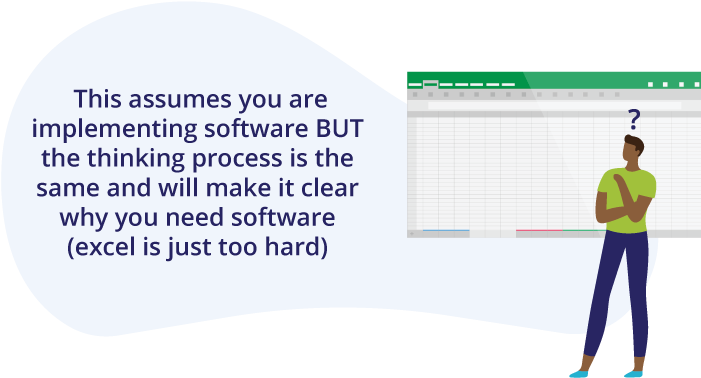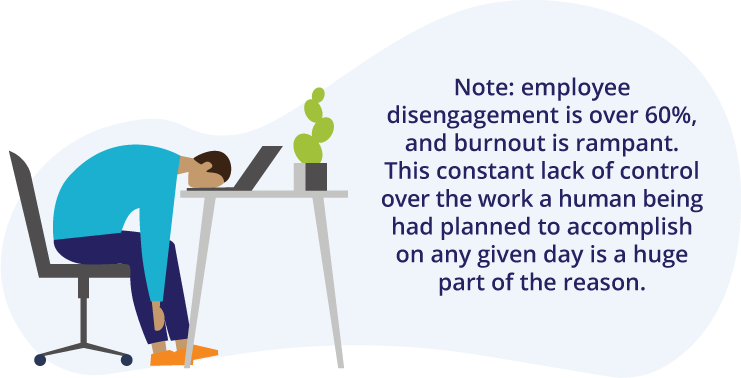When you are enacting culture change, bumps in the road are inevitable. Thankfully, there are steps you can take to make the process as smooth as possible while you strive to become a high-performance organization.
Here is our step-by-step change management checklist that will improve your organization’s resource management.

Step 1: Get an agreement with the sponsor on value measures for better resource management.
Step 2: Set up a clear way to monitor if those measures are being met as the change progresses.

Step 3: Have a kick-off meeting with all impacted parties (resource managers, portfolio managers, skill owners).

Step 4: Set up a town hall with all system users (i.e., resources/human beings.) Sell the WIIFM of the system. If you don’t think you have something wonderful to offer them, you are implementing it incorrectly. In this town hall, you should:
- Start by telling them that you know they are NOT resources and hereafter will be referred to as team members or the term of your choice.
- Create a policy that every person has some say in their assignments (this will improve performance and quality). Note: you might not be able to get this done the first time you suggest it to your sponsors and stakeholders but always hold fast to the fact that people should have some say in the work they do.
- Get agreement by “team assignment” managers (i.e. project managers, product managers) to be respectful and to value people’s time and work. Nothing is more important than this message.
- Consider using 25% as the minimum assignment criteria. Task switching kills productivity and it kills engagement.
Step 5: Be clear what features are important in your new resource management process, and in what order so team-members know why things are being done now and what will change in the future.

Step 6: To successfully implement an RM system, you need valid data. That means you should:
- True up, current assignment AND planned roll-off date (people may not be where you think they are).
- Encourage team members to re-estimate the actual end date of their assignment based on their workload.
- This might differ from what the project manager says – believe the resource.
- Identify the basic skills necessary to support the capacity planning and the project assignment process (these skills are minimal and will be upgraded later).
- This is often a job title and a functional skill.
- Match people to scheduled work. Any investment without at least a high-level project plan should go on the back-burner. Always deal with “knowns” first.
- Explain that you will use the What-if to help you sequence the project to fit the available resource capacity. (What-if is a modeling capability – it can be done by hand, but a tool is better).
Step 7: Once the capacity plan is laid out (usually as a result of a major portfolio update), set up an escalation protocol. Some of the assignments that were initially made will be wrong; the first time through, it’s impossible to get it right. Use Project Managers and Team members to help identify conflicts.
- The most common conflict once people begin to work on their new assignments is urgent “run the business” requirements. Do root cause analysis and see where the problem is. It rarely is the surprise all organizations make it out to be.
- The second conflict comes from poorly managed “projects.” Because most organizations have broken the concept of a TEAM and are managing work based on task assignments (not team assignments), things are more prone to “break” and take longer.
- Even if it’s an illusion, make sure everyone assigned to an approved body of work knows what the work is intended to accomplish, where the work stands in the overall priority list, and who else is doing work toward this outcome. Do this even if you are working with a fixed team/COE.
- Human beings are wired to include the context in their thinking. Deny people the information they need to make decisions, and you get an inferior product (known in the trade as “technical debt”).
Step 8: Never forget the role of sequencing. You get more done if you work on fewer things at a time. Overextending all team members on their first day is a recipe for lasting failure.
Step 9: Assuming the work is appropriately staffed and the structure problems (and underestimation of production work) have been solved, it’s time to disseminate and enforce the “fair trade rule.”
The most common example of this is team members who have a dual assignment to production work and “project” work. Every hour that “production work” eats into project work needs to be repaid.
- If a team member is 50% project work and 50% production and the production work takes ten extra hours in a week, then the Team Member spends 30 hours on the project next week rather than the scheduled 20.
- Pain should be equally shared. If it can’t be, then cancel a project or FIX the underlying product workload problem by hiring more people to solve the production problem.

Step 10: All the complexities and issues discussed above need to be solved before it makes sense to roll out new features. However, that does not mean there shouldn’t be a plan for when the “employee growth” elements of the system are enabled.
- Optimism is a fragile thing. Telling people they will have a way to plan their career growth in six months and then failing to deliver on that promise on time will lead to people quitting or doing poor work.
- At the same time, telling them it will be a year makes it sound like it isn’t a priority.
- Find the happy, believable middle ground.
Step 11: What you can do while you fix long term structural problems is invest in training. The days of long training programs are over. Microcredentials allow employees to work on mastering new skills even while they are using their old skills.
Step 12: Keep people involved. Everything does not need to be perfect. All culture change is an act of co-creation. Trust your people. Listen to your people. Take responsibility for solving the problems when they arise, and before you know it, you will have a high-performance organization.




